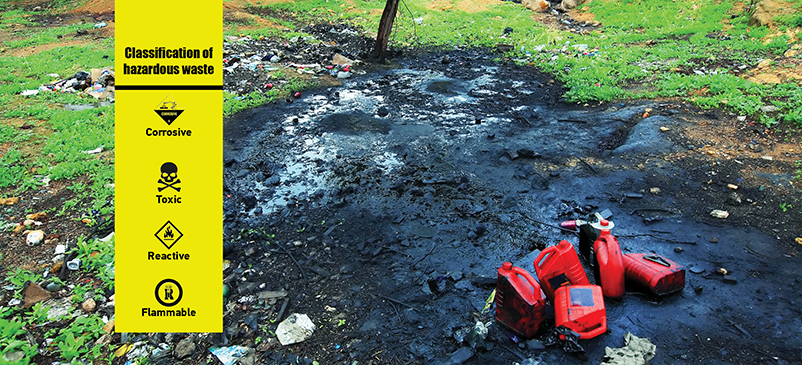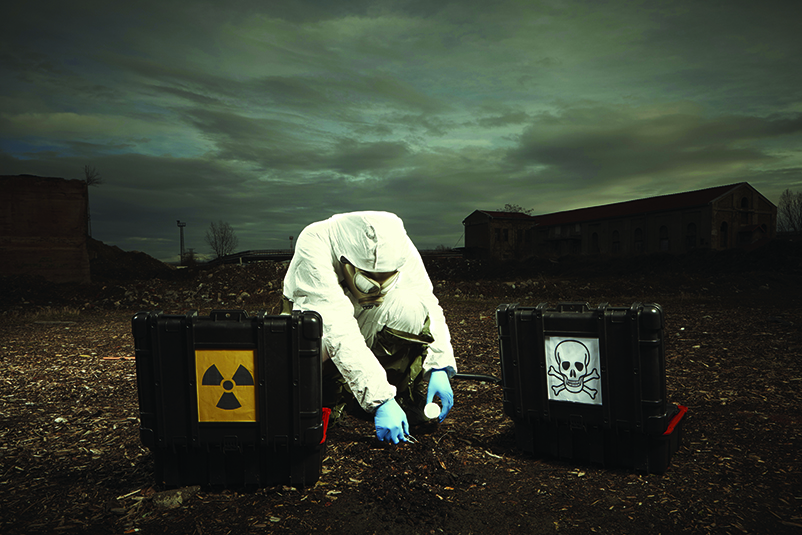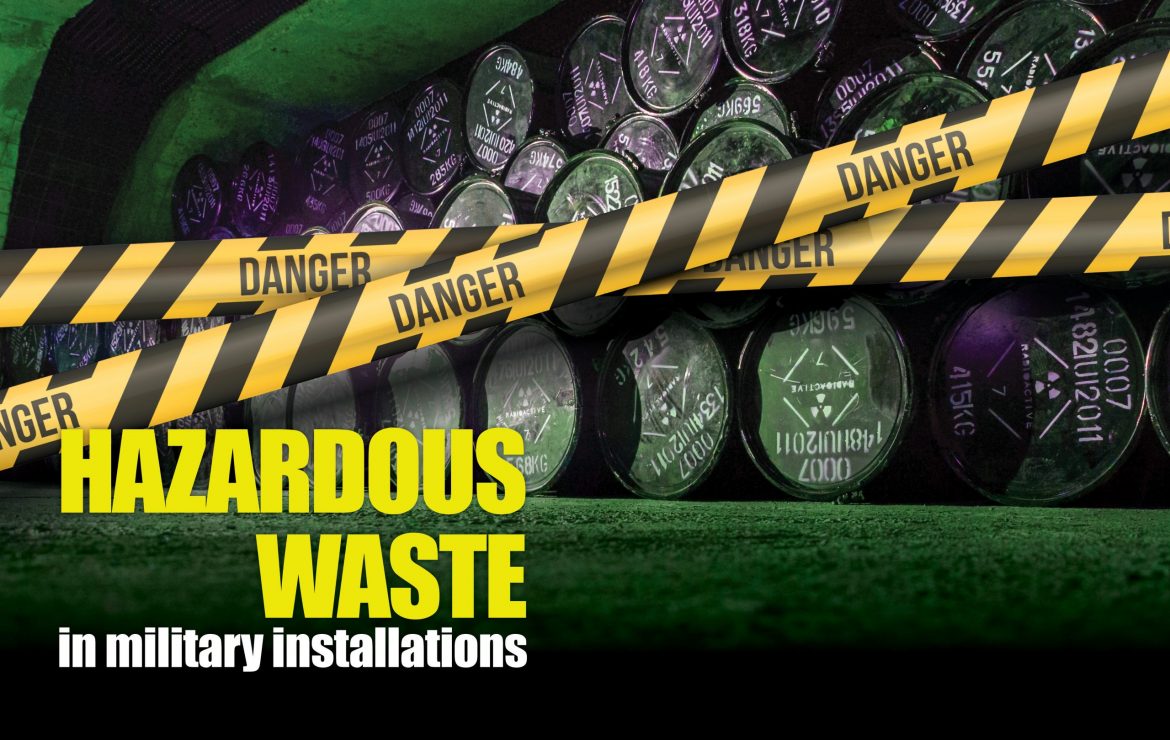The issue of hazardous waste has become one of the most important environmental challenges facing the world in recent years due to its high danger to humans and environment. It is widely spread, due to the multiplicity of its production sources and the increase in its quantities and types. In addition, the handling and transportation of hazardous waste requires environmental considerations based on very precise standards. Hazardous waste is produced from many sources in our daily life, the most important of which are agricultural, industrial, commercial and military sources. It exists in different forms and situations, including solid, liquid, and sediment. Hazardous waste, when handled in improper ways, causes disasters and accidents, and causes pollution of surface and ground water and soil. In certain cases, it can cause explosion, fire, disease and other hazards.

النفايات الخطرة في المنشآت العسكرية
Environmental and health effects of hazardous waste
The type and toxicity of hazardous waste depends largely on the industrial and technical progress of society, as developed countries produce large quantities of hazardous and toxic waste as a result of the progress of industry and resource consumption, and these wastes are characterized by their extreme danger to the elements of the environment because most of them are slow to decompose and are subject to accumulation and increase in living tissues. Due to the difficulty of disposing of these wastes, the direct and indirect costs of disposal increase, and they need effective control in terms of storage, transportation and treatment. According to the estimates of the United Nations Environment Program, the world annually produces about 400 million tons of hazardous waste. The (ECO WATCH) website indicates that the US Department of Defense annually produces 750,000 tons of hazardous waste, which constitutes more production than the five largest American chemical companies combined, and has left its toxic legacy around the world in the form of depleted uranium residues, oil, jet fuel, pesticides and lead weed removers such as Agent Orange and other hazardous substances. It is essential to effectively treat, store and dispose of this type of modern human-generated waste to preserve the planet for future generations.
From 1953 to 1987, the Marine Corps base at Camp Lejeune, North Carolina, polluted groundwater with harmful chemicals in concentrations well above those permitted by safety standards. As a result, an unspecified number of military personnel developed cancer and other diseases. In Colfax, Los Angeles, in previous years, the US military used to burn explosives and munitions’ waste several times a day without any environmental emissions control.
In 2017, some US media covered the news that the US Naval Station in Virginia Beach had spilled an estimated 94,000 gallons of jet fuel into a nearby waterway, less than a mile from the Atlantic Ocean. While the incident was by no means as catastrophic as some of the other pipeline spills, it highlights an important fact that hazardous waste from US Department of Defense facilities must be disposed of in an environmentally sound manner. In 2014, the former head of the Pentagon’s Environment Program told Newsweek that her office must deal with 39,000 polluted areas spread across 19 million acres in the United States alone. US military bases, both domestic and foreign, are consistently ranked among the most polluted places in the world, with perchlorate and other components of jet and missile fuels contaminating drinking water sources, aquifers and soil. Hundreds of military bases can be found on the US Environmental Protection Agency’s (EPA) list of sites eligible for government clean-up grants.
International standards for the description and classification of hazardous waste
1- Definition of hazardous waste: Hazardous waste is defined by the US Environmental Protection Agency as waste that has properties that make it hazardous or that could have a harmful effect on human health or the environment. Hazardous waste is also defined according to the International Basel Convention as the materials or things that are intended to be disposed of in accordance with national laws and regulations, and which require special methods to deal with and treat, as they cannot be disposed of in household waste disposal sites, due to their dangerous properties and negative effects on environment. and public safety. As for the World Bank, hazardous wastes are defined as wastes that contain compounds and permanent chemical elements that cause acute or chronic adverse effects on human health and environment. The World Health Organization also defined hazardous waste as waste because of its chemical, physical or biological properties, and it needs special handling and treatment when disposing of it to avoid health risks and harmful effects on environment.

Hazardous waste in military installations
2- How is waste classified as (hazardous)? Hazardous wastes are classified on the basis of their biological, chemical and physical properties. These properties generate substances that are either toxic, reactive, flammable, corrosive, infectious or radioactive. According to the classification of the US Environmental Protection Agency, waste can be considered (hazardous) in two cases:
The first case: If it is characterized by one of the following characteristics:
Corrosive: a substance due to its acidic or alkaline properties that causes metal corrosion.
Toxic: a substance that threatens the health of an organism when it is inhaled, swallowed, or in contact with the body of the organism.
Reactive: a substance that is not stable under normal conditions and can cause explosions or produce toxic gases and fumes.
Flammable: A substance that ignites and burns easily and quickly.
The second case: If the waste is on one of the lists of hazardous waste issued by international organizations concerned with the environment such as the US Environmental Protection Agency, the World Health Organization, Basel Convention, United Nations Environment Program and others.
Sources of hazardous waste in military installations:
Hazardous waste in military facilities is generated from operations and maintenance of systems, equipment and weapons, from military manufacturing and reconstruction of armored vehicles, and from the production of military equipment, materials, supplies, weapons and ammunition. Studies have shown that more than 80% of the hazardous materials and waste used in military installations result from the support services provided to the armament systems represented by maintenance procedures, such as antifreeze, paints resistant to chemical agents, solvents, and halons used in fire extinguishing system or in air conditioners, refrigerators, batteries, mineral oils, acids, brake oils and weapons’ cleaning materials, while the rest includes pesticides, chemical disinfectants, fuels, building materials that contain asbestos, electronic equipment containing mercury, and others. The type, size and characteristics of the hazardous waste resulting from military installations depend on the nature of the facility’s mission, its size and the extent to which environmental practices are applied therein. We rarely find a military facility that produces only one type of hazardous waste.
Basic principles of hazardous waste management
1- The Polluter Pay Principle: It implies that all waste producers are legally and financially responsible for the safe and environmentally sound disposal of the waste they have produced, and this principle attempts to limit the legal liability of the party causing the harm.
2- Precautionary Principle: It is a fundamental principle governing the protection of health and safety. This principle includes the assumption that the magnitude of the risk is significant and taking of appropriate preventive measures when the scientific evidence about health and environmental risks is uncertain.
3- Principle of duty of care: The Principle of Responsibility states that any person handling or managing hazardous materials or related equipment is ethically responsible for handling them with the utmost care.
4- Proximity Principle: Waste should be treated and disposed of as close to the production site as possible, and as technically and environmentally permitted.
Hazardous waste management in military installations
Despite the variety of quantities and types of hazardous waste resulting from military installations and their nature from one facility to another, the priorities of basic hazardous waste management are similar and differ in details and methods of implementation, this depends on the mission and nature of the military facility. The adjacent figure shows the priorities of hazardous waste management arranged in order of preference, Where the inverted pyramid indicates the expansion of methods of preventing and reducing waste production at the top and reducing methods of disposal at the bottom.
1- Preventing and Reducing Waste Production: It is a preventive method in dealing with waste before resorting to treatment or disposal to the environment. This is done by reducing the formation of pollutants in their sources by following the correct practices and methods in the operations and production processes inside the military facility and the use of materials that reduce the formation of pollutants, and this includes practices that reduce the use of materials, energy, water and production of hazardous materials, in addition to practices that protect and preserve natural resources. Pollution prevention policies aim to reduce the toxicity and volume of waste, and reduce expected environmental liabilities and risks. In one practical example, the US Air Force’s workshops switched from using the hazardous methylene chloride to remove paint from combat aircraft hulls to throwing plastic balls, and this new procedure reduced the production of hazardous waste, improved working conditions for users, and lowered costs.

النفايات الخطرة في المنشآت العسكرية
2- Recycling and Reuse: The word recycling means the effective use or reuse of waste as a raw material or in the components of the raw material as an input to the production process or waste reclamation to obtain useful partial products from the waste material, or the detoxification of the waste to make it suitable for reuse. Recycling requires examining the generated hazardous waste and production processes to identify opportunities for reuse, and this contributes to reducing waste disposal costs. At the same time, the use of recycled materials as an alternative to raw materials contributes to reducing raw materials costs, and materials replacement programs contribute to finding uses for recycled materials and identifying alternatives effective for raw materials. Recycling not only contributes to reducing the amount of waste emitted to be disposed of, but also helps preserve natural resources by reducing the need for new raw materials.
3- Processing: The process of treating hazardous waste means changing its chemical, physical or biological properties to detoxify compounds, isolate and concentrate hazardous pollutants in small quantities, and chemically stabilize the waste and transform it into insoluble solids before final disposal. In most cases, hazardous waste contains more than one pollutant, and this does not necessarily mean that we use all methods, classifications, and stages of treatment to get rid of a particular type of waste. The choice of the ideal method depends on the type, nature and characteristics of the hazardous waste, the available technical and financial means, costs, and occupational and environmental safety standards and considerations.
4- Final disposal: Discharging or throwing waste into air, water, or soil with or without treatment, such as disposal by landfill after using up all previous methods, provided that it includes reducing the volume of waste and studying the environmental and health risks resulting from that.
Military Munitions Rule
The nature of war in the twenty-first century has changed dramatically, and the lesson of the Gulf War is that the massive industrial age armies are no longer the pre-eminent force in the emerging strategic landscape. Modern warfare has become a conflict on a smaller scale, including international peacekeeping missions, counterinsurgency roles, and surgical strike operations. Success in these conflicts requires professional armies that are smaller in size and highly trained using the latest military technology. The military-industrial era of the Cold War resulted in massive amounts of unused ordnance stored in military warehouses and training sites, used ordnance and unexploded ordnance (UXO) across the USA, representing a backlog of decades of weapons development and readiness training. These military munitions are a legacy of the Cold War, and their problem is that they contain chemicals that are potentially hazardous to the environment, and the destruction and clean-up of these munitions poses special environmental and safety concerns. Congress has attempted to balance the U.S. military’s need for ongoing training with the desire of the Environmental Protection Agency (EPA) to get the military to clean up hazardous waste sites. To do so, Congress enacted (the Ordnance Rule), which, if managed properly, is designed to effectively achieve the goals of both the Army and the Environmental Protection Agency. The US Environmental Protection Agency consulted with the Department of Defense to develop the military munitions rule. After several meetings and proposals, the Environmental Protection Agency published the final rule that specified when munitions should be classified as solid waste. And when solid waste is classified as hazardous waste, it also provides for the safe storage and transportation of military ordnance waste under the Resource Conservation and Recovery Act, which requires the Department of Defense to transfer hazardous waste to facilities and agencies that process, store, and dispose of hazardous waste that has been approved by federal regulators or governmental. The law requires the Ministry of Defense to ensure that all sent hazardous wastes reach the approved facility through the hazardous waste manifest tracking system. The Ordnance Rule also includes standards applicable to the transportation of military ordnance waste, standards applicable to emergency response operations, and standards applicable to the storage of waste ammunition.
The Ammunition Rule states that military ordnance waste is items that have been abandoned, damaged, or irreparably degraded, identified for treatment and disposal, or identified as ammunition waste by an authorized military official. Unused munition becomes solid waste when it is discarded, incinerated, treated, removed from storage for disposal or treatment, or if the munition has been damaged, leaked, or worn to the point that it can no longer be returned to serviceable condition and cannot be recycled properly or used for other purposes. The Ammunition Rule indicates that ammunition waste is classified as a hazardous waste if it is toxic, reactive, flammable or corrosive. Facilities that store waste munitions are also required to perform a quarterly inspection and annual stock taking of hazardous waste materials to ensure items remain stable. If waste munitions contain liquid, the item must be stored in a facility with a containment subsystem to contain spills.
Conclusion
Hazardous waste is a real threat to human health and the environment, and its quantities and types are increasing every year, which are difficult to dispose of because of their stability and danger. Although the amount of hazardous waste generated from military sources is less than the amount of hazardous waste generated from industrial and agricultural sources, it is characterized by high risk and acute toxicity because it contains radioactive and explosive materials and chemicals of particular danger. Hazardous waste in military facilities is generated from maintenance, manufacturing, and operating systems and contains oils, chemicals, and other hazardous agents.
The principles of hazardous waste management require that it be disposed of as close to its production and the assumption of greatest risk when no hazard information is available for the waste and any person handling or managing hazardous materials or related equipment is ethically responsible for handling them with the utmost care. Waste producers are legally and financially responsible for the safe and environmentally sound disposal of the waste they produce. Priorities for the environmental management of hazardous waste in military facilities include waste prevention at source, recycling, reuse, treatment, and final disposal.
Recently, the disposal of hazardous waste from US Department of Defense facilities is subject to strict environmental laws, including the Resource Conservation and Recovery Act (RCRA), which regulates the management of hazardous waste from cradle (the moment it is generated) to the grave (the moment it is disposed of).
» By: Dr. Retired Colonel Eng. Khaled Ananzah
(Environmental and occupational safety consultant and trainer)













